Episcopate
In 1972 he was named Bishop of Huaraz, working for the reconstruction of the zone that was devastated by a powerful earthquake in 1970. On January 18, 1978, he was named Archbishop of Piura y Tumbes.
On September 26, 1980, he was assigned Archbishop of Arequipa by Pope John Paul II, an office that he would occupy for 15 years. Among his works, the creation of the Archbishop Archive and the organization of the First Congress of Ecclesiastical History stood out. He designed and published the First Pastoral Plan of the Archdiocese. In 1980, he allowed the return of the clergy of the Congregation of Camillus of Lellis, who assumed religious duty in the Honorio Delgado Hospital in the Parish N.S. del Pilar, taking charge of the directing of the play "La Posada". In 1984, he invited the Sodalitium Christianae Vitae to work in Arequipa.
On April 21, 1986, at the request of Prebendary José Francisco Peña y Pbro, Nicolás Factor Herrera Herrera canonically declared the clerical jurisdiction of the new Sanctuary of Chapi as the Archdiocese Sanctuary of Our Lady of the Candlemas of Chapi through Decree N 023-C-ARZ-86.
In 2000 he was named Vice President of the Council for Peace.
In 2002 he was the mediator between the government and the citizens of Arequipa in the conflict over the privatization of the company Egasa.
In 1996 he retired due to the age limit and resided in the Parish of Our Lady of Fatima of Milaflores, the place where he would die of a heart attack the morning of December 8, 2003. His remains were transferred to the city of Arequipa, where he received the farewell from the faithful and the authorities led by the mayor Juan Manuel Guillén in a mass officiated by Bishops Bambarén and Piñeiro, to later be deposited in the Sacristy of the Basilica Cathedral of Arequipa.
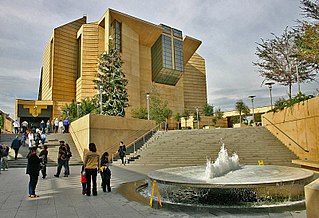
The Archdiocese of Los Angeles is an ecclesiastical territory or archdiocese of the Catholic Church located in the southern portion of the U.S. state of California. The archdiocese’s cathedra is in Los Angeles, the archdiocese comprises the California counties of Los Angeles, Santa Barbara and Ventura. The cathedral is the Cathedral of Our Lady of the Angels in Los Angeles, and its present archbishop is José Horacio Gómez Velasco. With approximately five million professing members, the Archdiocese of Los Angeles is numerically the single largest diocese in the United States.

The Roman Catholic Archdiocese of Manila is the archdiocese of the Latin Church of the Catholic Church in Metro Manila, Philippines, encompassing the cities of Manila, Makati, San Juan, Mandaluyong, and Pasay. The cathedral church is a minor basilica located in Intramuros, which comprises the old city of Manila. The Blessed Virgin Mary, under the title Immaculate Conception, is the principal patroness.
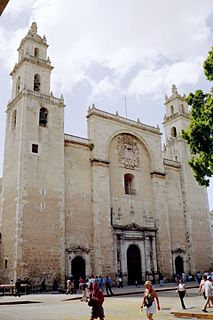
The Roman Catholic Archdiocese of Yucatán is the diocese of the Catholic Church based in Mérida, Yucatán, Mexico; the Campeche and the Tabasco are its suffragans. Its area is that of the state of the same name, covering an area of 17,204 square miles.

Sodalitium Christianae Vitae (SCV), or Sodalitium of Christian Life is a Society of Apostolic Life of Pontifical Right, according to the Code of Canon Law which governs the Latin Rite branch of the Catholic Church. It was founded in Lima, Peru, by Luis Fernando Figari on 8 December 1971. It acquired its present canonical form when Pope John Paul II gave his Pontifical approval on 8 July 1997. The Sodalitium was the first male religious society in Peru to receive papal approval. By 1997 there were Sodalit communities in several countries.
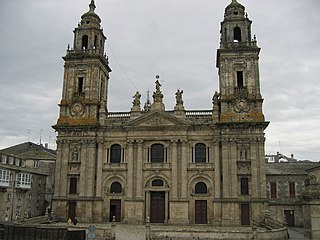
The Catholic Diocese of Lugo is one of the five Roman Catholic sees within Galicia, in north-western Spain, and one of the four suffragans in the ecclesiastical province of the Metropolitan Archdiocese of Santiago de Compostela.

The Roman Catholic Diocese of Huaraz is a diocese of the Latin Rite of the Roman Catholic Church in Peru. Erected in 1899, the diocese is a suffragan of the Archdiocese of Trujillo

The Roman Catholic Metropolitan Archdiocese of Santo Domingo is a Latin Metropolitan Archdiocese in the Dominican Republic. The see was erected 8 August 1511 as the Diocese of Santo Domingo and elevated to archdiocese on 12 February 1546.

The Roman Catholic Archdiocese of Lima is part of the Roman Catholic Church in Peru which enjoys full communion with the Holy See. The Archdiocese was founded as the Diocese of Lima on 14 May 1541. The diocese was raised to the level of a metropolitan archdiocese by Pope Paul III on 12 February 1546. One of its archbishops was the saint Torribio Mogrovejo.

The Metropolitan Archdiocese of Bogotá is a particular church of the Roman Catholic Church in Colombia. It was established in 1562 as the Diocese of Santa Fe en Nueva Granada, elevated to an archdiocese two years later, and was given its current name in 1891. It serves nearly 3.8 million Catholics in Bogotá and parts of the Cundinamarca Department, and covers a total area of 4,109 km2. The current metropolitan archbishop is Luis José Rueda Aparicio since 2020.
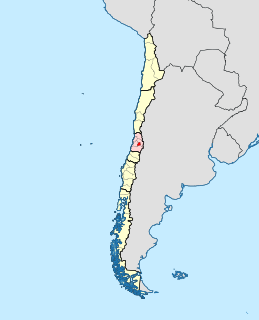
The Roman Catholic Archdiocese of Santiago de Chile is one of the five Latin Metropolitan sees of the Roman Catholic Church in Chile.

The Roman Catholic Archdiocese of San Fernando is the archdiocese of the Latin Church of the Catholic Church in the province of Pampanga, Philippines and the suffragan sees of Balanga, Iba, and Tarlac. Florentino G. Lavarias, D.D., was installed as archbishop of the archdiocese on October 27, 2014, succeeding Paciano B. Aniceto, D.D.

The Archdiocese of Oviedo is an Archdiocese of the Roman Catholic Church in Spain. The archdiocese encompasses roughly the current autonomous community of Asturias or Principality of Asturias. Erected in the 9th century, the diocese was elevated to an archdiocese in 1954. The diocesan see is in the city of Oviedo, where the Catedral de San Salvador is located.

The Roman Catholic Archdiocese of Cusco is a Latin Metropolitan archdiocese with see in the city and old Inca imperial capital of Cusco, in Peru.

The Roman Catholic Archdiocese of Arequipa is an archdiocese located in the city of Arequipa in Peru. It was erected by Pope Gregory XIII on 15 April 1577 at the request of King Phillip II of Spain.

The Roman Catholic Archdiocese of Piura is an archdiocese located in the city of Piura in Peru.

The Roman Catholic Archdiocese of Tuguegarao is an ecclesiastical territory or diocese of the Catholic Church in the Philippines. Tuguegarao is a river delta city that became center of the archdiocese in the Province of Cagayan, on the island of Luzon. Its seat is located at the Saint Peter's Metropolitan Cathedral.

The Roman Catholic Diocese of Novaliches is a diocese of the Latin Church of the Roman Catholic Church in the Philippines. The diocese was created by Pope John Paul II on December 7, 2002 by virtue of his Apostolic Constitution Animarum Utilitati, and was canonically erected on January 16, 2003 from the Archdiocese of Manila. The diocese previously existed as the Ecclesiastical District of Quezon City-North, which was renamed the District of Novaliches in 2002.

Joseph Vincent Brennan is a prelate of the Roman Catholic Church who has been serving as bishop of the Diocese of Fresno in California since 2019. He previously served as an auxiliary bishop of the Archdiocese of Los Angeles from 2015 to 2019.
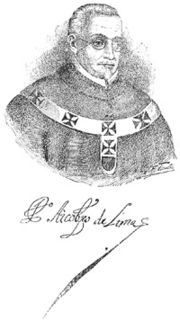
Pedro de Villagómez Vivanco was a Roman Catholic prelate who served as Archbishop of Lima (1640–1671) and Bishop of Arequipa (1632–1640).

The Theological Seminary of Bogotá, commonly known as the Major Seminary of Bogotá is a Roman Catholic major seminary located in Bogotá, Colombia, and serving both the Archdiocese of Bogotá and the Diocese of Facatativá. With history dating back to 1581, it is the oldest seminary in the Americas, and today is the largest and most prominent seminaries in Colombia, with dozens of alumni having been appointed bishops, archbishops, and cardinals. In addition to religious leaders, two Colombian presidents have been associated with the seminary. José Manuel Marroquín, the 27th President of Colombia, studied there in the 1840s, and Miguel Abadía Méndez, who was president in the 1920s, taught Latin at the seminary in the early 20th century.



















